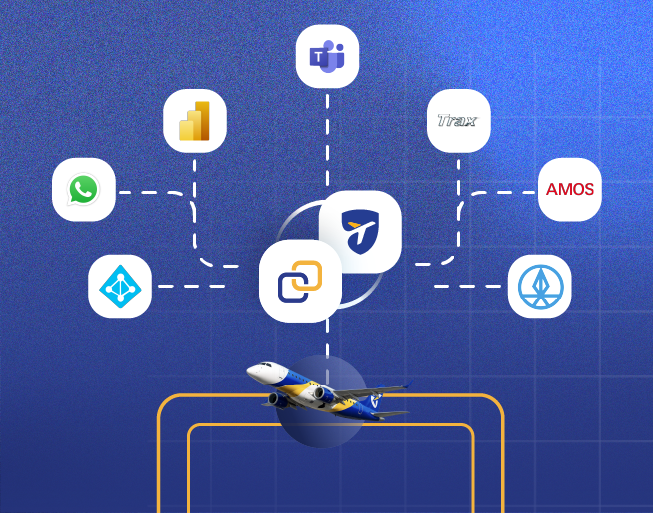AireXpert Aligns with Partners Across Your Tech Stack for a Seamless Experience
Bring real-time visibility to airline tech ops with AireXpert integrations. Connect legacy and modern systems securely, go live in ~2 weeks, and cut duplicate entry.
Explore all the integrations and connectivity AireXpert brings to your Tech Ops Crews.

When your systems don’t talk, your aircraft don’t turn.
Airline tech ops lives and dies by how fast accurate data moves across people, platforms, and processes.
AireXpert positions connectivity—not just communication—as the multiplier for maintenance performance, “making data flow effortlessly between systems.” This case study shows how operators stand up a lightweight integration in days, reduce duplicate entry, improve Maintenance Operations Control (MOC) visibility, and accelerate decisions—without a heavy IT lift.
Why keep reading: you’ll see the exact integration scope, payload, security posture, support model, rollout checklist, and the outcomes airlines report after going live.
The Airline Tech Ops Problem: Fragmented Data, Slow Decisions
Disconnected planning, maintenance, and records platforms force crews to swivel-chair between tools, retype the same data, and chase clarity through side channels. That creates delays, inconsistent records, and approval bottlenecks.
AireXpert reframes the problem around movement of trusted data:
“AireXpert transforms how aircraft operators manage maintenance operations… by making data flow effortlessly between systems.”
Question: If you mapped your last ten events from “discrepancy raised” to “decision made,” how many steps were wasted on finding or re-entering the right data?
Integration Strategy Built for Airline Tech Ops
Bridge Modern and Legacy Stacks
AireXpert “integrates easily with both legacy systems and modern solutions (AMOS, Trax, Maintenix, Sabre, Snowflake, and more)… to make sure the right data is available where it’s needed, inside AireXpert and beyond.”
Practical take: you don’t have to refactor the entire stack. Start where duplicate entry and slow hand-offs hurt most, then expand.
Choose the Best-Fit Transport
“We support read/write via API, webhooks, file transfers, and data lake connectors. We can provide other options if needed.”
How to choose:
- APIs for near real-time workflows and bi-directional needs.
- Webhooks for event-driven pushes without polling.
- SFTP/file transfers for stable, batch-friendly systems.
- Data lakes (e.g., Snowflake) for analytics or hub-and-spoke distribution.
The Starter Integration: Fastest Path to Value
Most operators begin with “a lightweight connection that brings essential aircraft discrepancy data directly into AireXpert.”
Minimum dataset moved when a new discrepancy is raised (e.g., TRAX/AMOS/Maintenix):
- Location (e.g., SEA)
- Tail Number (e.g., N123AX)
- Discrepancy Title (e.g., Captain Seat Track Broken)
- Status (Event Open/Close)
Optional fields as you scale: ATA Chapter, ETR/Advise Time, Logpage Numbers, Confidence Level, Custom fields.
Why this works: it delivers instant visibility to the people who act, without waiting on a full enterprise data model.
“This integration helps Maintenance Control crews avoid duplicate data entry, improves real-time Event tracking, and accelerates operational decisions.”
Example Payload and Processing
Incoming message to AireXpert (API/webhook/file, etc.):
{ "location": "SEA",
"tail_number": "N123AX",
"discrepancy": "Captain Seat Track Broken",
"unique_record_id": 12345,
"status": "Event Open"}
“Once received, data is processed instantly, enabling real-time updates.”
Implementation tip: standardize field names and casing up front; document the mapping so audit, IT, and end users share a single source of truth.
Security and Compliance for Airline Tech Ops
Security approvals often decide the implementation timeline. AireXpert is “SOC 2 and GDPR compliant, with data encryption at rest and in transit,” and enforces “strong authentication & access controls.”
What this means for you: security teams get the artifacts they need; IT can move forward with confidence. If you require deeper review, “request a copy at our Trust Center.”
Ownership, Monitoring, and Support
Who keeps the pipes healthy?
“AireXpert monitors integration health 24/7, with automated alerts and rapid-response ITS support. We maintain our side of the integration and can often help troubleshoot issues on the operator’s integration processes.”
Result: fewer internal tickets, faster incident resolution, and clear lines of responsibility.
Rollout Timeline and IT Checklist
Most partners are “fully operational within 2 weeks, not months.”
Your IT prep, simplified:
- Provide preferred data transfer method (API/webhook/file/SFTP).
- Identify the key fields for the Starter Integration.
- Assign an IT point of contact.
- Schedule the kickoff with AireXpert ITS.
- Participate in test data transfers (AireXpert guides this step).
Once live, “we handle integration monitoring, updates, and support—your crew just keeps the data flowing.”
AireXpert also helps “with mobile app deployment on company devices” and “firewall adjustments (if needed for any features).”
Documented Outcomes Airline Tech Ops Teams Report
Operators consistently point to four wins after go-live:
- “Eliminated manual double-entry.”
- “Improved MOC visibility.”
- “Faster maintenance decisions.”
- “Better data sharing across departments.”
Customer feedback echoes the ease of getting started:
“Integrating AireXpert was surprisingly simple. Our crews immediately saw the benefits—not just in reduced manual work, but in how much faster we could respond to events.”
Value proposition distilled: less swivel-chairs and status chasing; more time on the work that returns aircraft to service.
Implementation Tips for Your First 30 Days
- Start with the smallest payload that moves decisions: Location, Tail, Discrepancy, Status, Unique ID.
- Validate with synthetic cases, then flip to live.
- Add optional fields after the first week of stable flow.
- Publish baseline KPIs (time from discrepancy raised → controller acknowledgment; number of system “swivels” per event; duplicate entries/day), then track weekly deltas.
- Share Trust Center materials with audit/IT on day one to avoid late-stage security surprises.
Frequently Asked Questions
What integration methods are supported?
“Read/write via API, webhooks, file transfers, and data lake connectors.”
Which systems can you integrate with?
“Modern systems (AMOS, Trax, Maintenix, Sabre) and legacy systems—including homegrown solutions.”
How is data secured?
“SOC 2 and GDPR compliant, with data encryption at rest and in transit,” plus strong auth and access controls.
Who maintains the integration?
AireXpert “monitors integration health 24/7” and maintains its side; the operator provides feeds and validates data quality.
What does our IT crew need to do?
“Provide data feeds and be available for quality assurance of the data. AireXpert is going to guide you through the entire process.”
Airline tech ops performance is a data problem as much as a labor problem. The fastest gains come from moving the right maintenance data to the right people at the right moment—without asking crews to retype or reconcile in three places.
AireXpert’s Starter Integration gives you a low-friction way to prove value fast: a minimal payload, secure transport, 24/7 monitoring, and an expansion path to optional fields and bi-directional flows.
Action steps:
- Identify where duplicate entry or slow hand-offs block decisions.
- Stand up the Starter Integration with the minimum dataset.
- Validate mappings, go live, then layer optional fields.
- Track time-to-decision and MOC visibility weekly to show impact.
Call to action: Ready to connect your maintenance stack without a heavy lift? Talk to AireXpert about the Starter Integration and see real-time airline tech ops in action.
Quick Facts
- Scope: Starter Integration for airline tech ops events.
- Core fields: Location, Tail Number, Discrepancy Title, Status, Unique Record ID.
- Methods: API, webhooks, SFTP/file, data lake (e.g., Snowflake).
- Security: SOC 2, GDPR, encryption at rest/in transit, strong auth/access controls.
- Timeline: Typically live in ~2 weeks.
- Outcomes: Eliminated double-entry; improved MOC visibility; faster decisions; better cross-department sharing.
- Support: 24/7 integration monitoring, alerts, and rapid-response ITS.



